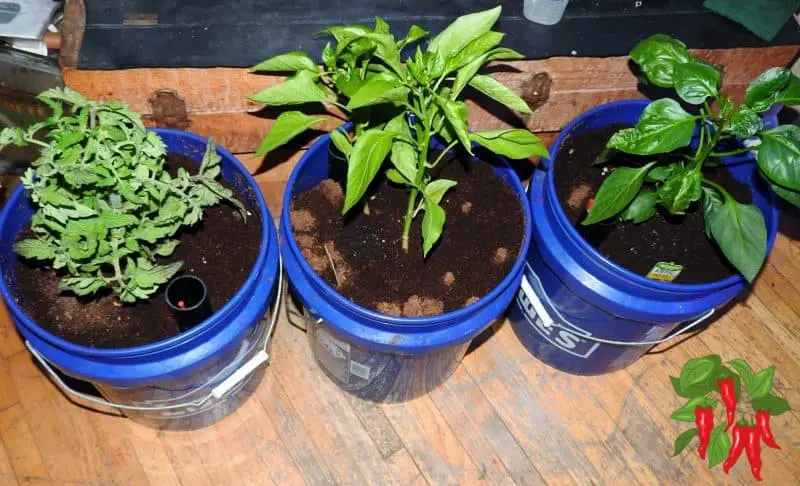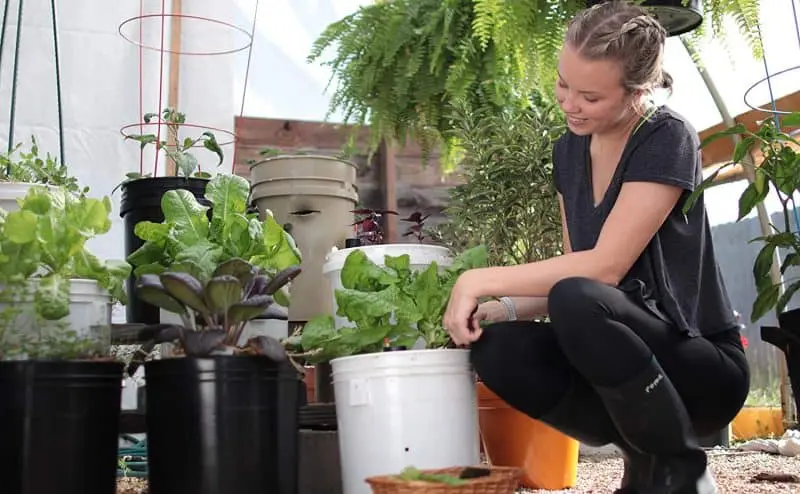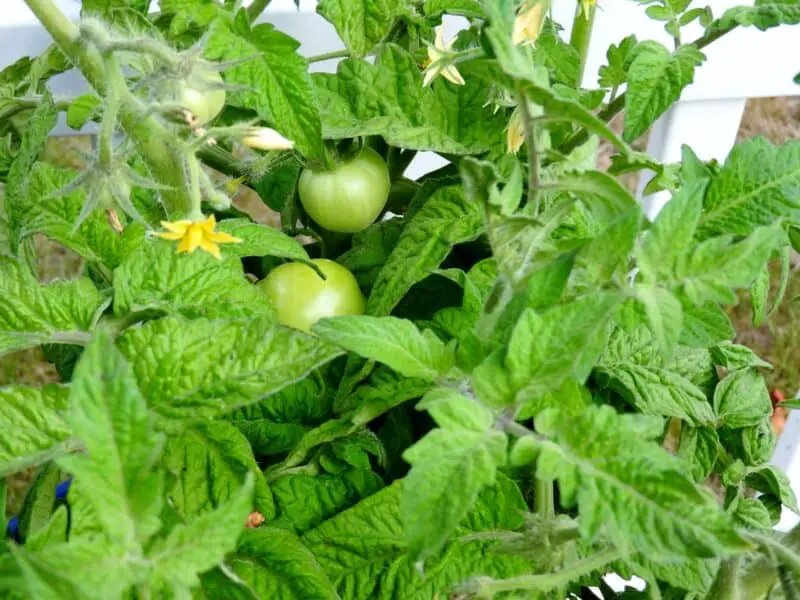This post contains affiliate links. If you buy something from one of our links we may earn a commission. Thanks

Discover how to grow vegetables in coco coir, a sustainable choice for modern gardeners. Dive into our guide for a greener, lush harvest all year round!
Whether you grow in an apartment or outdoors growing vegetables in coco coir offers several important advantages over using soil.
Growing Vegetables In Coco Coir Key Takeaways:
- To grow vegetables in coco coir, begin by hydrating the coir to prepare it and mixing it with 25% perlite.
- Fill your containers or beds with coco coir.
- Use a balanced coco fertilizer, and maintain a consistent watering schedule with a nutrient solution.
- Coco coir’s excellent water retention and aeration offer a conducive environment for vegetable growth.
How To Grow Vegetables In Coco Coir
Embarking on the journey of growing vegetables in coco coir opens a window to a sustainable, efficient, and rewarding gardening experience.
It’s not just about sowing seeds and reaping the produce; it’s a green step towards eco-friendly urban agriculture.
Whether you’ve got a green thumb or are just starting out, exploring coco coir as your growing medium is like turning a new leaf in your gardening book.
What is coco coir?
Coco coir is a versatile and sustainable growing medium that can be used for a variety of plants, both indoors and out.
Made from the fiber of coconut husks, coco coir is an environmentally friendly alternative to peat moss or other soil amendments.
It holds moisture well while still providing good drainage, making it an ideal growing medium for those looking to grow their own food at home.
Whether you are an experienced gardener or just starting out, coco coir can help you cultivate a beautiful and healthy garden all year round.
In this article, we will talk about coco coir’s advantages and how to use it for growing vegetables and getting maximum results.
Advantages Of Growing Vegetables In Coco Coir
Coco coir or coco peat as it is sometimes called can give vegetable growers an edge over growing in soil mixes.
Coco coir is a unique growing medium made from recycled coconut husks. It is reusable, unlike potting soil mixes.
To get the best results using coco coir you need to realize it is not like soil or peat.
Coco peat works great in containers, it also works great in beds and because of its superior wicking capabilities, it is also great for sub-irrigated planters(SIP) often also called self-watering planters.
- Neutral PH Coco coir has a natural pH of around 6.0 which vegetable plants prefer.
- Light Weight Coco coir weighs much less than soil so easier to move around
- Smaller pot size Coco coir allows you to use half the pot size you would need for soil
- Reusable Coco can be reused over and over unlike peat-based soil mixes
- Renewable Coco coir is made from coconut shells that are recycled. Peat is mined from our wetlands.
- Better water to air ratio Coco retains water well while offering much better air for the roots even when wet.
How To Prepare Coco Coir For Growing Vegetables?
 If you want to use coco coir for growing vegetables you need to prepare it first. Coco Coir is nothing like potting soil.
If you want to use coco coir for growing vegetables you need to prepare it first. Coco Coir is nothing like potting soil.
Coco Coir Is Not Soil!
Forget everything you know about growing in potting soil. Coco is actually considered a hydroponic medium.
If you use it like soil plants will grow ok but if you learn to use it correctly you will be amazed at what it can do for your plants!
If you have been using potting mixes they usually come with added nutrients and other amendments. Coco is primarily a grow media.
Before you use it you will need to add fertilizer to it. You will also be watering and feeding your plants differently.
Never Let Coco Coir Dry Out
Coco should remain moist at all times. Don’t keep it soaking wet constantly but don’t let it totally dry out either.
Never water coco coir with plain water either. Coco should be watered with a nutrient solution. I will explain why.
How To Fertilize Coco Coir
Because coco coir is unique you want to build the correct nutrient profile and maintain it.
If you run straight water through it you would wash out nutrients and throw your soil chemistry out of balance.
Coco should be watered with a nutrient solution at every watering.
But because we will water it frequently it will be a weaker nutrient solution than what is used for potting soil.
Coco Coir Needs Extra CalMag
I don’t want to turn this into a lesson on soil science so simply put coco has a unique soil profile.
Coco coir really needs a fair amount of calmag to balance things out. Also if you are growing under LED lights plants use more calmag.
Here is what I found to be the best calmag. It can be important for maintaining the right nutrient balance.
Every soil or grow media has a certain number of sites in it that can hold on to nutrients.
Some have more sites than others. This is called CEC or cation exchange capacity.
Clay soils have the most while most inert hydroponic mediums have much less. The higher the CEC the more nutrients it can hold.
Coco coir will latch on to some nutrients to the exclusion of others and that is not what we want. Coco has a low to medium CEC.
Coco will naturally want to hold on to potassium but if it does it will push out calcium and magnesium.
Too much potassium can lock out other needed nutrients. So we feed coco with calcium and magnesium which pushes out excess potash.
Once we have things balanced we don’t want to add straight water because it upsets the balance.
We will always use water with some nutrients but it is important to water until there is runoff so salt does not build up in the pot.
If you want more information on the science here is a good article:
Hydroponic Coir Substrate Science | Manic Botanix
The Secret To Amazing Growth In Coco Coir
The secret to getting amazing results with coco coir depends on maintaining this nutrient balance.
So calmag is added to any complete fertilizer you are using because they generally don’t have enough on their own.
It would be good if you had a TDS meter to measure your nutrient strength. A pH meter would also be very helpful.
I use about 300 ppm per gallon of calmag plus 3-500 ppm of complete fertilizer depending on plant size.
I use about 300 ppm for seedlings and then 600 for larger plants and about 8-900 ppm for producing plants.
But it is important to learn to read your plants so you know if you are over or underfeeding them.
Coco Coir Varies In Quality
Not all coco coir is the same. Coconuts grow by the seashore and absorb a lot of salt.
This needs to be flushed out if it is for growing plants but a lot of coco is sold for bedding and is not flushed.
I like Canna Coco and have used it for years and the quality is always high.
There are other brands that sell decent coco too but I prefer Canna Coco. This is the best coco coir.
This is one of the best nutrient lines for feeding plants in coco, and if you follow directions you cant go wrong.
How To Grow Vegetables In Coco Coir FAQ
Here are some frequently asked questions about growing vegetables in coco coir.
Can you plant in just coco coir?
Yes, it is possible to grow vegetables in coco coir without adding any additional soil or growing medium.
Coco coir alone has excellent water holding capacity and drainage without the need to add other soil amendments.
Can you grow tomatoes in coco coir?
 Yes, tomatoes can be successfully grown in coco coir. They grow exceptionally well in it.
Yes, tomatoes can be successfully grown in coco coir. They grow exceptionally well in it.
In fact, many types of vegetables thrive when grown in coco coir, including peppers, eggplants, cucumbers, squash, and beans.
Is coco coir good for carrots?
Yes, coco coir can be a great growing medium for carrots.
In fact, many types of root vegetables, including potatoes, carrots, and turnips, can thrive when grown in coco coir.
To help maximize growth and soil health when growing carrots in coco coir, be sure to provide adequate space between plants to allow for adequate airflow.
Additionally, many common outdoor carrot pests like carrot root fly and wireworms will probably not be present indoors.
What is the best soil mixture to grow carrots?
The best soil mixture to grow carrots is not a mixture at all but is straight coco coir without stones or perlite.
This is the best growing medium for carrots. Because if carrots hit a stone or piece of perlite it will cause them to grow forked roots.
What is the best soil for tomatoes?
Tomatoes can grow in a wide variety of soils and are very adaptable. So there is no one best soil for tomatoes.
However, coco coir is an excellent growing medium for tomatoes, as it provides good drainage and aeration while still holding moisture well.
Is coconut coir good for raised garden beds?
While you may think garden beds are for outdoors they can be used inside too.
In fact, there are self-watering planter beds for sale on Amazon. You can see some examples here.
Coco coir can be a great option for raised garden beds, as it is lightweight and easy to work with.
So if you need to move a raised bed in your apartment it will weigh less than half that of a bed full of potting mix.
Additionally, coco coir drains well and does not compact easily, making it ideal for raised garden beds.
To use coco coir in a raised garden bed, simply add it to the bed along with any compost or other organic matter you want.
Be sure to monitor the moisture level of the bed regularly, as coco coir can dry out quickly.
This is much less of a problem in a self-watering planter.
With proper care, you can grow a wide variety of vegetables and plants in a coco coir-based raised garden bed.
How do you use coconut coir indoors?
Coco coir can be a great growing medium for indoor plants, as it holds moisture well and provides good drainage.
To use coco coir indoors, simply add it to your pots or containers instead of using potting soil.
Remember too that unlike peat-based soil mixes coco coir is a sustainable and renewable resource, making it an environmentally friendly option for those looking to grow their own food.
Is coir good for soil?
Yes, coco coir is as good an option for growing vegetables as soil is.
Even better it is a sustainable and renewable resource, while potting mixes contain peat moss.
Peat is stripped out of our wetlands destroying our habitat.
Does coco coir need nutrients?
Yes, coco coir is a relatively inert growing medium. It does not contain enough nutrients to grow plants well.
So coco coir will need some added nutrients in order to support healthy plant growth.
This can be done by using a fertilizer specifically formulated for use with coco coir.
Coco coir requires high amounts of calcium and magnesium. This is called calmag. Here is what I found to be the best.
In addition, it requires a balanced fertilizer preferably made for coco. This is one of the best for coco, just follow directions.
Is coconut coir good worm bedding?
Yes, coco coir can make excellent worm bedding.
![Worm Factory 360 Adding Worms 30 Day Update [ Happy Worms! ]](https://www.indoorvegetablegrower.com/wp-content/uploads/DSCN0445-800x600.jpg) It holds moisture well and provides good drainage and aeration.
It holds moisture well and provides good drainage and aeration.
I have a worm farm and I always start each bin with a layer of coco. The worms love living in it.
To use coco coir as worm bedding, simply add a layer of it to your worm. The worms will live in and aerate the coco coir.
Add your food scraps on top of this layer.
Does coco coir need perlite?
Not usually, no. Most coco coir products already provide the right balance of moisture and aeration, so they do not usually need additional perlite added in.
Many people do add perlite to their coco coir. They are often running hydroponic systems that use high-frequency feeding and irrigation.
By decreasing drying downtime with added perlite they can feed and water more often. However, for most of us, perlite is not needed.
Can you reuse coco coir?
Yes, coco coir can be reused multiple times. However, it will eventually break down and need to be replaced.
To reuse coco coir it is best to let it dry down. It will come out of the pot as a block. Then break it down removing any large roots.
Then place it back in your pot and water and refertilize it as if it were brand new.
Is coir better than compost?
They are not the same so you really can’t compare them. Coco coir is primarily a growing medium that needs to be fertilized before use.
Compost is broken down food or other organic matter that does contain nutrients and is used as an additive to other grow media.
You can certainly add compost to your coco coir and have the best of both worlds.
How To Grow Vegetables In Coco Coir Final Thoughts
Growing vegetables in coco coir is more than just a gardening venture; it’s a step towards embracing sustainable practices.
With its remarkable water retention and aeration capabilities, coco coir creates an ideal haven for your veggies to thrive.
Moreover, its lightweight nature and reusability make it a cost-effective choice for gardeners.
As you learn how to grow vegetables in coco coir your garden will not only witness the flourishing greens but you’ll also contribute to a sustainable, eco-conscious gardening community.
So, if you’re envisioning a garden that’s both lush and environmentally friendly, coco coir is your go-to companion.
Coco coir is a great choice for growing plants, both indoors and outdoors.
With proper care and attention, coco coir can help you grow a beautiful and healthy garden, regardless of your location or climate.
So why not give it a try and start growing vegetables in coco coir today?
How To Use Grow Bags For Vegetables To Kickstart Your Growth (indoorvegetablegrower.com)





